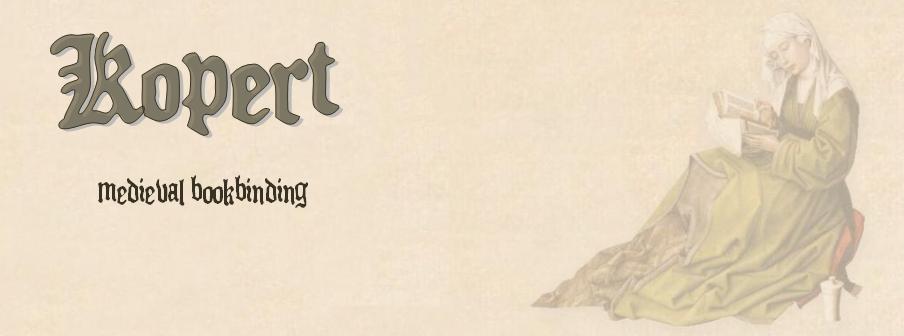 First, an overall view of the book, lying on the cream-coloured chamois I'm going to use for the inner book cover, under the textile book cover that really forms the Beutelbuch.
First, an overall view of the book, lying on the cream-coloured chamois I'm going to use for the inner book cover, under the textile book cover that really forms the Beutelbuch.You can see the three raised bands on the spine, that is the hemp cords the sections are sewn onto. The ends of the cords were frayed so they really lie flat when pasted to the oak boards. At the ends of the spine you can see additional cords called headbands. Those were sewn onto the spine ends after sewing the sections to the raised bands. At this time, they don't look very decorative as you can see in the next foto:

It's just a plain cord lying on top of the pages...
"What for?" you may ask - but this is just the first step :-)
The headbands are used for different purposes. On some books, the leather cover is sewn to them to fix it and to protect the spine from dirt. Not very pretty, but usefull...
The headbands can also be a decoration AND a protection for the book, when headband and leather cover are fixed together not with plain sewing but with one or more strips of leather braided over the headband and through the leather of the cover. This very prominent braid can be the same colour as the leather or a contrasting colour or it can even be a multicoloured design.
But those leather braided headband are not very practical if you want to put a book upright on a shelve as it is normal today...
 For a girdle book, this also does not work, at least not for the outer cover.
For a girdle book, this also does not work, at least not for the outer cover.The next option is to wrap the headband with thread before you cover the boards with leather - and this is what I did here. As the outer cover is going to be silk fabric, I used silk thread instead of the more common red and white linnen thread for the headbands.
The actual design is not taken from a surviving book, this is just my idea what would look nice when its peeking over the top of the pages when you read the book. Surviving examples often show a very asymmetrical arrangement of colours or are just executed in one colour. But I liked the two dark red stripes in the green silk wrapping to be almost symmetrical (I didn't measure with a ruler or something, I just changed colour when I thought fit. When you look at medieval books, precision to the millimeter seemes to be a concept totally strange to the medieval bookbinder...)
The next steps will be: Putting another layer of glue unto the spine, covering the boards with the (inner) leather cover, attaching the clasps and finally putting on the (outer) silk cover that will extend over the lower part of the book and have a turkish knot on the end...
Way to go, I think I'm almost halfway through :-)


Ah, how nice!
ReplyDeleteA wearable book would be a very handy thing for a merchant to have (not in exquisite silk, of course), for noting the bits and pieces sold.
Hm. Maybe I'll go and exercise my hobbyist's bookbinding skills ; ) to make me one for when my current notebook runs out, though that will be a while. Even if it's a good bit later than my "normal main time"... sigh.